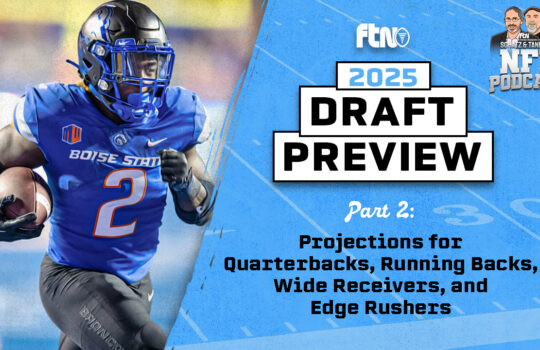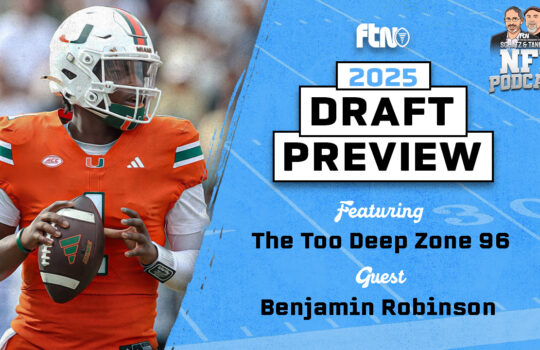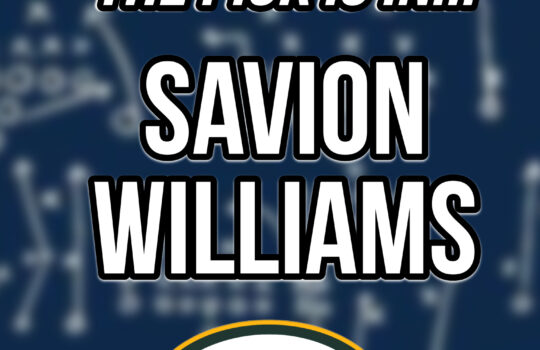
Week 1 is in the books, and National Jump to Conclusions Week is in full swing.
Every year, going from zero games played to one sets off wild speculation and immediate hot takes, forgetting entirely that at this point last season we had ‘learned’ that the big-name additions to the Los Angeles Chargers defense would shine after they thumped the Raiders (they ended up 21st in defensive DVOA); that Carson Wentz was a definite upgrade at quarterback for the Washington Commanders after throwing four touchdown passes (he’d finish with a -19.3% passing DVOA, compared to a -5.7% from Taylor Heinicke in 2021); that the Cincinnati Bengals’ offensive line was going to doom them after they allowed seven sacks against Pittsburgh (they finished 16th in adjusted sack rate), and that the San Francisco 49ers couldn’t win without Jimmy Garoppolo after falling to the Bears in a monsoon (see Purdy, Brock).
So take Week 1’s results with some grains of salt, or at least a somewhat skeptical eye. The Cowboys will be good, yes, but they’re not going to win 40-0 every week and make their opponents look like they had never heard of the concept of pass protection before. The Bengals did not sign the Wicked Witch of the West to coordinate the offense and are unlikely to melt into a fine goo at the slightest sign of bad weather, though our projections are still somewhat dubious on them as a whole. The Rams may be better than people gave them credit for, but Sean McVay and a crew of nobodies are unlikely to be a serious threat this season. Overreact to Week 1 at your own risk.
A fun corollary to Jump to Conclusion Week is the prime breeding ground for “on pace” takes; pure catnip for stats nerds across the land. Take a player’s Week 1 stats, multiply them by 17, and voila! You have records prone to fall across the league.
Josh Allen didn’t just have a bad night on Monday. He’s on pace to throw 51 interceptions this season, shattering George Blanda’s record of 42. Of course, say goodbye to Night Train Lane’s record of a paltry 14 interceptions in 1952; Jordan Whitehead‘s on pace for 51 interceptions and would knock Lane right off the tracks. And, in an awfully big coincidence, that would also tie the new single-season record for sacks, which will be shared by T.J. Watt, Drake Jackson and the other Josh Allen.
It’s nonsense. Fun nonsense, but nonsense notwithstanding. Tua Tagovailoa, Kirk Cousins and Matthew Stafford all not going to all break Peyton Manning‘s single-season passing yards record. Eric Dickerson does not need to lose sleep over Christian McCaffrey and Breece Hall knocking down his rushing record. LaDainian Tomlinson will not see his single-season points marked eclipsed by no fewer than 15 different players, from Nick Folk to Brandon Aiyuk to Tyler Allgier. And, of course, Calvin Johnson…
Hrm. Well, actually…
Tyreek Hill may not have topped Week 1’s DYAR rankings, but his 215 receiving yards against the Chargers is one of the most impressive opening day performances in the history of the league. It’s the third-highest receiving total for a player in his team’s first game of the year, trailing only Frank Clarke’s 241 yards for the Cowboys in 1962 and Anquan Boldin‘s 217 for the Cardinals in 2003. Hill and Tagovailoa were in near-perfect sync on the deep ball. Hill’s 91 deep receiving DYAR nearly lapped the rest of the league in Week 1, with only Rashid Shaheed getting even halfway to that mark. Hill’s frankly unfair speed makes him uniquely challenging for opposing defenses to cover; he was clocked in at over 21 miles an hour on multiple plays on Sunday. There just aren’t any cornerbacks who can keep up with him when he’s granted a free release. And Mike McDaniel has done a great job, getting Hill in pre-snap motion to help him hit that top speed faster. If you’re as lost as the Chargers were on Sunday, you’re going to have a nightmare of a day.
Is Hill going to hit the 3,655 receiving yards he’s on pace for? No, of course not, don’t be ridiculous. But that’s not his goal. Hill has repeatedly stated that he wants to be the first player to hit 2,000 receiving yards in a season. When you knock out more than a tenth of it on opening day, we have to stop and take notice.
And it’s not like this was a fluky game from Hill, either. That 241-yard day for Frank Clarke in 1962? He was capable of putting up big numbers from time to time in the unbalanced 1960s; he was the one who ended up teaching Bob Hayes how to catch the deep ball, after all. But that was a clear career outlier for him, one of just four days he topped 150 receiving yards. Anquan Boldin‘s 217 yards? That came on his very first day as a pro and he never duplicated it, topping 150 yards only six more times and only on super-high volume days. He wasn’t that sort of deep threat.
But this sort of game is second nature to Hill. This was the third 200-yard receiving day of his career, tying him for the sixth all-time, sitting behind Hall of Famers Lance Alworth, Calvin Johnson, Don Hutson and Jerry Rice and AFL legend Charley Hennigan. His 12 150-yard games are tied for 13th all-time, more than any other active player. And, of course, he has a benefit that those Hall of Famers never had – he gets to play that 17th game. Johnson would have needed 125 receiving yards per game to hit 2,000; Alworth would have needed 143. Hill just needs 118, meaning he put in nearly two games worth of work on Sunday. A nice cushion to have.
The 2,000-yard mark is going to fall, and soon. The season isn’t getting any shorter. Passing, despite being down in Week 1 this season, is still far easier than it has ever been with all the restrictions placed on defenders. We’ve had serious challengers in each of the last two seasons. In 2021, Cooper Kupp came up just 53 yards short, unable to overcome three straight sub-100 yard games in September and October while he was still gaining chemistry with Matthew Stafford. Last year, Justin Jefferson finished 191 yards short, held to just five catches for 53 yards in his last two games. These assaults on the record are only going to become more frequent. You need so much to go right to get there – good health for you and your quarterback, plenty of shootouts to rack up big yardage totals, an offensive scheme built around your ability to distort defenses. But the environment keeps getting easier, and someone is going to be the first to write their name in the history books.
The question, then, is when does “on pace” become an actual attempt on a record, and not just a fun exercise of showing off your multiplication tables knowledge? Any player making a serious attempt on the record is going to need days like Hill’s game against Los Angeles to boost his standing, but he will also need a steady diet of 100-yard games to keep chipping away at the total. After all, Hill isn’t the only receiver on pace today to break 2,000 yards; Justin Jefferson, Brandon Aiyuk, Tutu Atwell and Puka Nacua would also set the record if they just repeated their Week 1 games over and over and over again. When does it stop being a good game, and become an exceptional season?
To try to answer that, I went back and looked at every single receiver since the NFL started keeping track of individual statistics in 1932. I counted how many would have been on pace for the 2,000-yard season through their team’s Xth game, if they had had the benefit of playing 17-game seasons, giving us an idea of just how common it is to be on pace for the mark at any particular point in history.
First thing to note is that yes, we could write this article about someone every year. The NFL has averaged 3.4 players on pace for 2,000 receiving yards through Week 1 every year since they’ve started keeping track of these things. That’s jumped to 5.7 per year in the 20 years since the NFL sharpened their rules on illegal contact, and a ridiculous 12 players managed to pull it off in 2019.
Hill is special because of just how far ahead of pace he already is and the fact that he’s been here before. Just last season, Hill had 1,104 yards through Week 9, putting him on pace for 2,085 yards on the year. But Miami’s offense couldn’t keep up its torrid early pace, with Hill only topping 100 receiving yards two more times all season. Things get harder later – the weather gets colder, lowering offensive totals, and the aches and pains of the long season begin to take their toll even if players remain healthy enough to play. It’s not enough to just to be on pace; you want to build an early cushion to account for that tougher sledding later. Hill lucks out a bit in that category this season, though – four of Miami’s last five games are in Florida, where the weather should be less of a factor. It’s not quite as big of an advantage as Calvin Johnson playing in a dome in five of his last seven games in his record-setting 2012 season, but it’s one fewer potential hurdle for Hill.
You can see from the table that any sort of serious attempt on the record requires you to not just be really, really good at football, but to have some kind of structural advantage.
Don Hutson is shockingly still the record holder for most receiving yards though a team’s first nine games, a record set all the way back in 1942. Hutson is credited for the invention of the receiver position as we know it, creating many modern passing routes. But it certainly helped that there was a minor conflict going on in 1942, and Hutson got to play against the sorts of athletes who weren’t strictly needed for the war effort. Crazylegs Hirsch benefitted from the 1950s Rams being the first team to regularly use three wide receiver sets, specifically designed to get him out on flank. Charley Hennigan was a very good receiver who got to play in the very early years of the AFL, before they got quite up to the NFL’s talent level across the board. We are unlikely to see those sorts of major advantages ever appear again, leaving the middle of this table probably unassailable.
And then we get back to Calvin Johnson. The reason we’re talking about Hill possibly cracking the 2,000-yard mark is because Johnson came up just short. A 225-yard day against the Falcons in yet another Detroit loss left Megatron needing just 108 yards to crack 2,000 entering the final day of the season. He had topped that mark in eight straight games entering the season. The Lions, sitting at 4-11, had nothing to play for, and could dedicate their entire offense to throwing the ball to Johnson if they wanted to. But he had to face the Chicago Bears, who led the league with a -26.8% pass defense DVOA that season and had held him to a season-worst 34 yards earlier in the year. The Lions targeted him 14 times, trying shot after shot to get him to 2,000, but he could only pull in five catches for 72 yards. Had Johnson had the 17th game, he would easily have topped 2,000, and Hill would be going for the still impressive but less viscerally satisfying single-season record. If Hill does hit the milestone, but takes 17 games to do it, some Detroit fans may call for an asterisk.
But to get back to the question, at what point should we really start a 2,000-yard watch? Things begin to get interesting if players remain on pace through the first month of the season, so more than 470 yards in their first four games. That’s the point where we start getting fewer than one qualifying player per season even in the modern era; players who take a significant lead at that point generally go on to win the year’s receiving title barring injury. But you can see how even modern-day qualifiers drop like flies as the year goes on, with no one managing to stay on pace through three quarters of a season in over a decade at this point. If we find Hill sitting at 1,400 yards coming into that last stretch, with four out of five games in South Florida? That’s when it becomes worthwhile to start checking out opponents and matchups and trying to piece together the exact path for 2K. That’s when history stops being something potentially happening, and becomes something possible.
Until then, just enjoy Hill being fast. He’s on pace to blow past a zillion cornerbacks this year, and we’ll meet back up in December to see how that’s gone.


















































 New York Jets
New York Jets  New England Patriots
New England Patriots  Miami Dolphins
Miami Dolphins  Buffalo Bills
Buffalo Bills  Pittsburgh Steelers
Pittsburgh Steelers  Cleveland Browns
Cleveland Browns  Cincinnati Bengals
Cincinnati Bengals  Baltimore Ravens
Baltimore Ravens  Tennessee Titans
Tennessee Titans  Jacksonville Jaguars
Jacksonville Jaguars  Indianapolis Colts
Indianapolis Colts  Houston Texans
Houston Texans  Las Vegas Raiders
Las Vegas Raiders  Los Angeles Chargers
Los Angeles Chargers  Kansas City Chiefs
Kansas City Chiefs  Denver Broncos
Denver Broncos  Washington Commanders
Washington Commanders  Philadelphia Eagles
Philadelphia Eagles  New York Giants
New York Giants  Dallas Cowboys
Dallas Cowboys  Minnesota Vikings
Minnesota Vikings  Green Bay Packers
Green Bay Packers  Detroit Lions
Detroit Lions  Chicago Bears
Chicago Bears  Tampa Bay Buccaneers
Tampa Bay Buccaneers  New Orleans Saints
New Orleans Saints  Carolina Panthers
Carolina Panthers  Atlanta Falcons
Atlanta Falcons  San Francisco 49ers
San Francisco 49ers  Seattle Seahawks
Seattle Seahawks  Los Angeles Rams
Los Angeles Rams  Arizona Cardinals
Arizona Cardinals 








 Boston Celtics
Boston Celtics  Brooklyn Nets
Brooklyn Nets  Philadelphia 76ers
Philadelphia 76ers  New York Knicks
New York Knicks  Toronto Raptors
Toronto Raptors  Chicago Bulls
Chicago Bulls  Detroit Pistons
Detroit Pistons  Milwaukee Bucks
Milwaukee Bucks  Cleveland Cavaliers
Cleveland Cavaliers  Indiana Pacers
Indiana Pacers  Orlando Magic
Orlando Magic  Atlanta Hawks
Atlanta Hawks  Charlotte Hornets
Charlotte Hornets  Miami Heat
Miami Heat  Washington Wizards
Washington Wizards  Denver Nuggets
Denver Nuggets  Minnesota Timberwolves
Minnesota Timberwolves  Oklahoma City Thunder
Oklahoma City Thunder  Portland Trail Blazers
Portland Trail Blazers  Utah Jazz
Utah Jazz  LA Clippers
LA Clippers  Golden State Warriors
Golden State Warriors  Los Angeles Lakers
Los Angeles Lakers  Phoenix Suns
Phoenix Suns  Sacramento Kings
Sacramento Kings  Dallas Mavericks
Dallas Mavericks  Houston Rockets
Houston Rockets  Memphis Grizzlies
Memphis Grizzlies  New Orleans Pelicans
New Orleans Pelicans  San Antonio Spurs
San Antonio Spurs 










